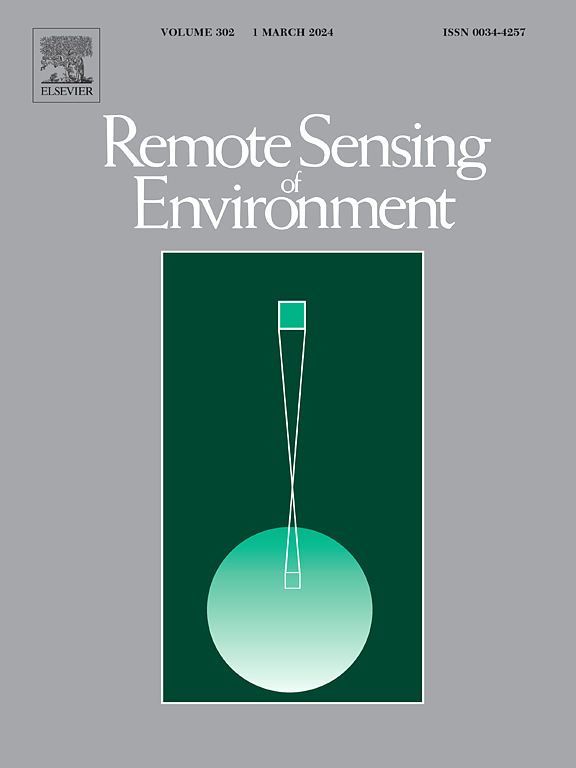在内陆水域生成稳健的10米Sentinel-2/3合成水生反射带
IF 11.4
1区 地球科学
Q1 ENVIRONMENTAL SCIENCES
引用次数: 0
摘要
内陆水域包括各种水生系统,包括河流、湖泊、泻湖、水库等,卫星数据在提供这些复杂生态系统的整体和动态观测方面发挥着至关重要的作用。然而,现有的中等空间分辨率卫星传感器,如Sentinel-2多光谱仪器(MSI),通常是为陆地监测而设计的,缺乏适合水应用的光谱带和辐射质量。本研究开发了一种新的合成波段生成方法,称为Sentinel-2/3 synthetic Aquatic Reflectance Bands (S2/3Aqua),用于从Sentinel-2 MSI和Sentinel-3 OLCI图像对之间的多元回归分析中计算8个10 m合成光谱波段。采用多元线性回归(MLR)、多元二次回归(MQR)和随机森林回归(RFR) 3种多元回归模型,在10 m Sentinel-2图像上复制Sentinel-3的光谱一致性。基于现场观测(n = 54)开发了蓝藻模型,并首次在两个富营养化热带城市水库(promiss本文章由计算机程序翻译,如有差异,请以英文原文为准。
Generation of robust 10-m Sentinel-2/3 synthetic aquatic reflectance bands over inland waters
Inland waters comprise various aquatic systems, including rivers, lakes, lagoons, reservoirs, and others, and satellite data play a crucial role in providing holistic and dynamic observations of these complex ecosystems. However, available medium-spatial resolution satellite sensors, such as Sentinel-2 Multi-Spectral Instrument (MSI), are typically designed for land monitoring and lack suitable spectral bands and radiometric quality for water applications. This study developed a novel synthetic band generation method, called Sentinel-2/3 Synthetic Aquatic Reflectance Bands (S2/3Aqua), for computing eight 10-m synthetic spectral bands from multivariate regression analysis between Sentinel-2 MSI and Sentinel-3 OLCI image pair. Three multivariate regressor models, Multivariate Linear Regressor (MLR), Multivariate Quadratic Regressor (MQR), and Random Forest Regressor (RFR), were applied and assessed to replicate the Sentinel-3 spectral consistency on 10-m Sentinel-2 images. A cyanobacteria modeling was developed based on in-situ observations (n = 54), and we demonstrated, for the first time, the application of 10-m harmful algal bloom mapping over two eutrophic tropical urban reservoirs (Promissão and Billings, Brazil). Additionally, the generalization of S2/3Aqua was assessed by comparing its spectral signatures across different water optical types. Overall, the comparison between S2/3Aqua and Sentinel-3 bands achieved a mean absolute error of 6 % and a mean difference close to zero. We found that MLR exhibited a higher accuracy with in-situ observations (with a 28 % bias) and was more suitable than other tested models. S2/3Aqua also performed satisfactorily across all eight spectral bands, including at 620 and 681 nm, with a mean difference of less than 0.003 reflectance units. The cyanobacteria mapping showed a high level of agreement between S2/3Aqua and Sentinel-3 for low concentrations of Phycocyanin (less than 50 mg m−3), and S2/3Aqua effectively captured the spatial variability of narrower and smaller blooms. Finally, S2/3Aqua provides reliable synthetic spectral bands that can effectively be used in several aquatic system studies, including monitoring potentially harmful algal blooms.
求助全文
通过发布文献求助,成功后即可免费获取论文全文。
去求助
来源期刊

Remote Sensing of Environment
环境科学-成像科学与照相技术
CiteScore
25.10
自引率
8.90%
发文量
455
审稿时长
53 days
期刊介绍:
Remote Sensing of Environment (RSE) serves the Earth observation community by disseminating results on the theory, science, applications, and technology that contribute to advancing the field of remote sensing. With a thoroughly interdisciplinary approach, RSE encompasses terrestrial, oceanic, and atmospheric sensing.
The journal emphasizes biophysical and quantitative approaches to remote sensing at local to global scales, covering a diverse range of applications and techniques.
RSE serves as a vital platform for the exchange of knowledge and advancements in the dynamic field of remote sensing.
 求助内容:
求助内容: 应助结果提醒方式:
应助结果提醒方式:


